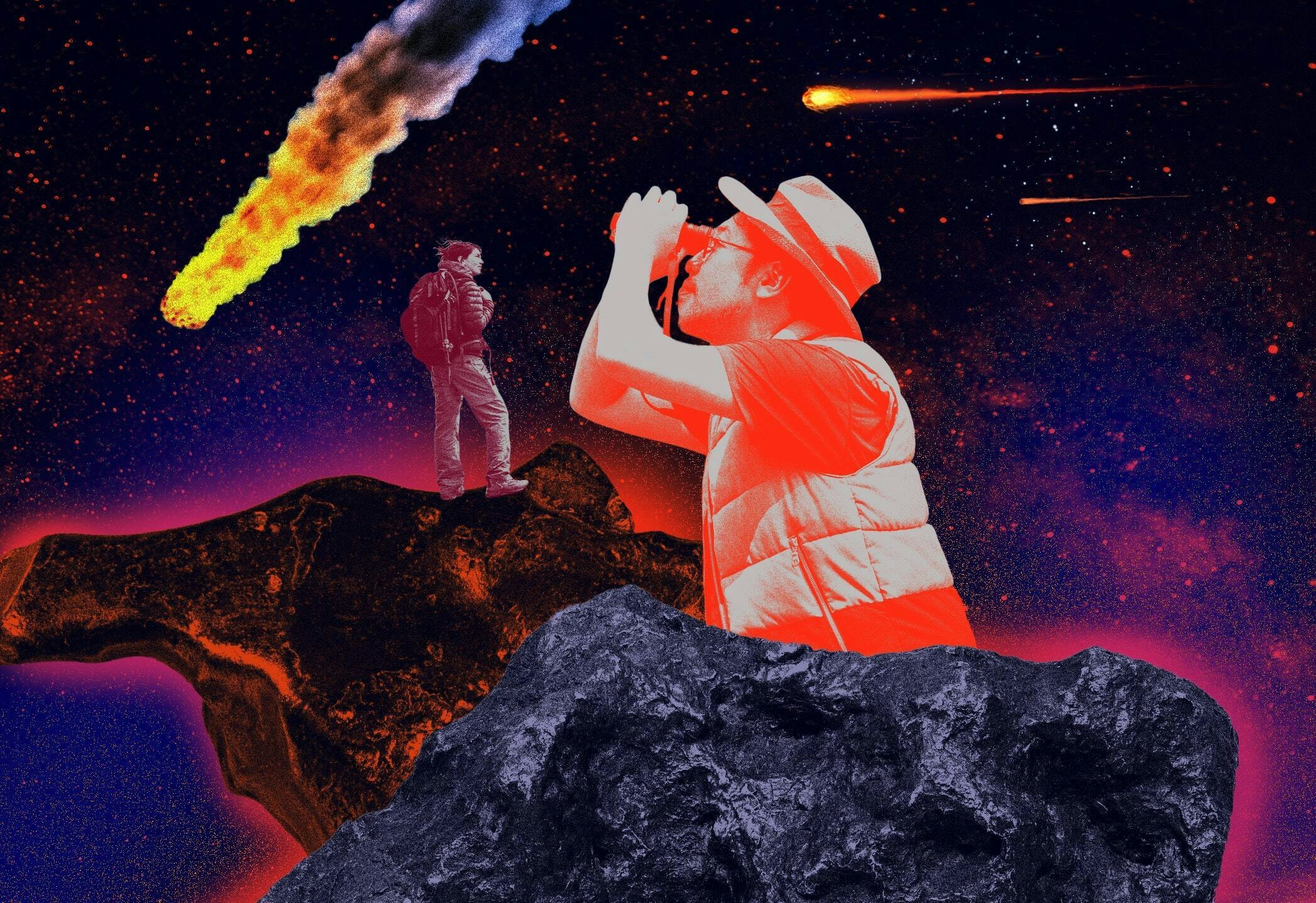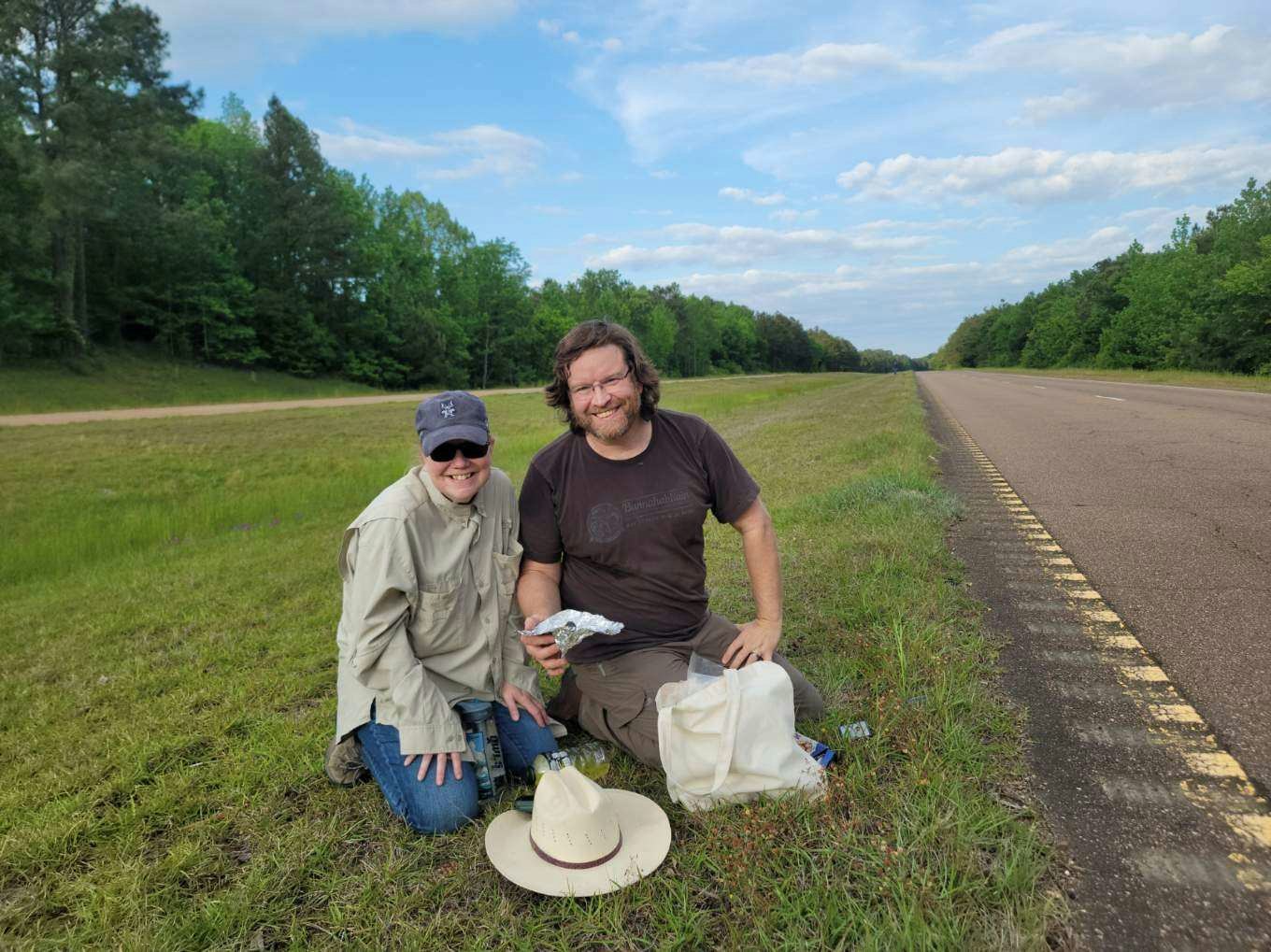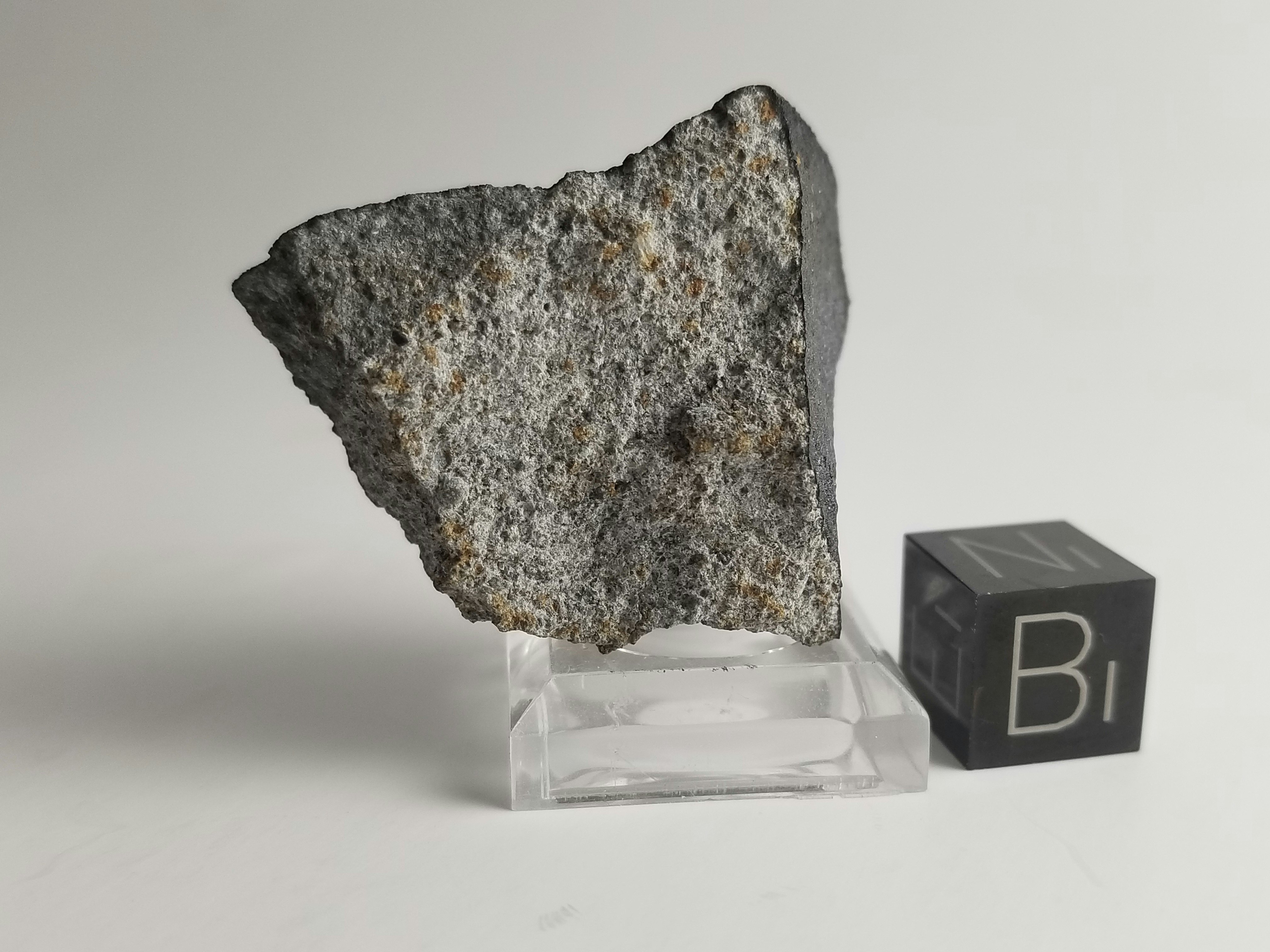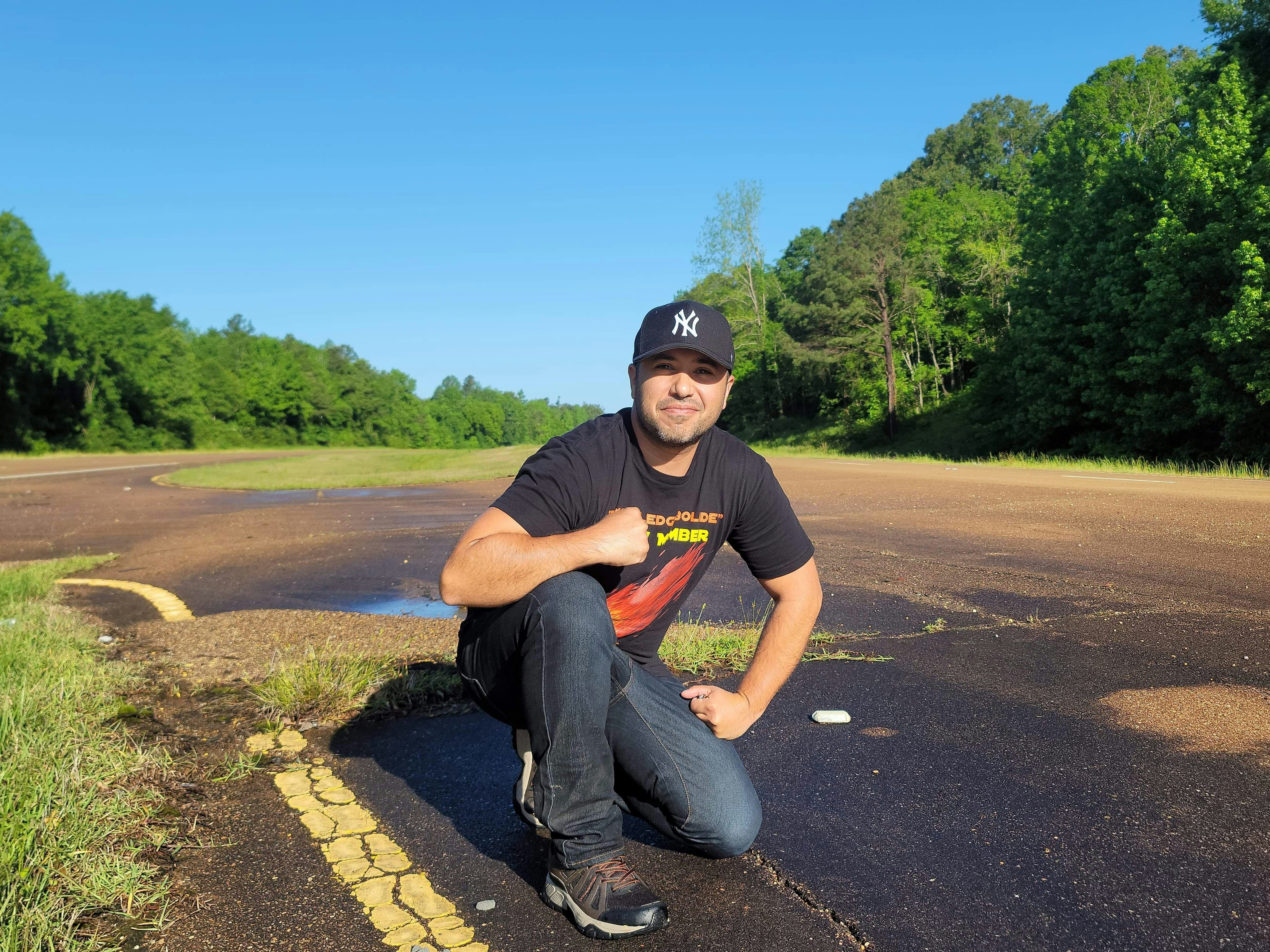
The day was shaping up to be a total flop for Matthew Stream and Roberto Vargas.
The two meteorite collectors were in the remote, unincorporated community of Cranfield, Mississippi, in late April, days after a fireball exploded over the area. Witness reports of multiple sonic booms convinced the pair to fly out on a whim to scour the ground for fallen rocks. Before this trip, they’d only ever communicated on Facebook, where they decided to team up and do the trip together.
But despite their best efforts, the search was not going to plan. Stream and Vargas trudged through swampy grasses and forests for hours. The air was thick with mosquitoes, and the ground crawled with lizards and venomous snakes. At one point during the trip, their rental car got stuck in the mud, and they had to ask a local to tow them out. Worst of all, at that point, they were empty-handed. Not even the slightest remnants of an alien rock were anywhere in sight.
“We were discouraged, disappointed; we started driving back,” Stream tells Inverse.
Their luck changed when Stream and Vargas drove past two people jumping up and down on the side of the highway.
“I [saw] this guy on his knees waving his hands at this woman down the road,” Vargas recalls.
Vargas pulled the car over and ran up to the exuberant man. “Did you just find meteorites?” he yelled.
The answer was yes.
A mutual benefit
The man with the newly found treasure was Marc Fries, a planetary scientist at NASA Johnson Space Center. As Stream and Vargas were driving by, Fries was signaling enthusiastically to his wife, Linda Welzenbach-Fries, also a planetary scientist. The couple had taken a spontaneous and tiring five-hour drive from their home in Houston to Mississippi after they, too, heard about the fireball and decided it was too good to miss.
And for Fries, this find was particularly special: It was the first freshly fallen meteorite he’d found independently.

In his professional life, Fries heads up NASA’s cosmic dust collection. But despite the group’s reliance on meteorite samples, he doesn’t typically search for the debris himself. Rather, Fries and others in his field often work with independent collectors like Stream and Vargas to do the hunting for them.
“There’s kind of a symbiosis that’s developed between meteorite hobbyists and hunters and scientists,” Fries tells Inverse. When meteorite falls are reported, hunters and collectors rush to the scene. But scientists don’t always have the time to drop everything and scour the ground, Fries says.
And for members of the meteorite community like Stream and Vargas, contributing findings to scientific research is a significant part of their work.
“Being a meteorite hunter, you’re kind of on the cutting edge of science,” Vargas says. He doesn’t have a formal background in geology or astronomy, but he’s donated material to NASA and interacted with the researchers studying the samples. Stream, too, regularly works with universities and institutions to classify space rocks.
The symbiosis fuels a greater search: The hunt for information about the origins of the universe. Meteorites are some of the oldest known pieces of planets, asteroids, and other celestial bodies. And to humanity’s luck, those ancient fragments are littered all over Earth. Someone just has to go out and find them.
Meteorites 101
Our solar system is full of asteroids. These rocky bodies are billions of years old, like the planets, but not big enough to be planets. They typically hang out in the Asteroid Belt between Mars and Jupiter and occasionally bump into each other, producing debris. These smaller pieces of rock also orbit the Sun and, over time, may assume orbits very different from their parent asteroid.
If these smaller bits and pieces happen to make their way toward Earth and gravity pulls them into our planet’s atmosphere, they burn up, producing streaks of light we call meteors. Most meteors are shed by comets, but this debris is fragile and does not survive their fiery re-entries. The much rarer asteroid fragments are stronger and more durable, so practically all meteorites — the nuggets left on the ground from exploded meteors — come from big pieces of asteroids.
Every year, there are about 10 potential meteorite falls in the United States, Bill Cooke, who leads NASA’s Meteoroid Environment Office at Marshall Space Flight Center, tells Inverse. “They’re like a monthly event.”

But usually, only five or six falls a year are confirmed after people find fragments on the ground and report them. In turn, verifying a fall relies heavily on where those meteorites land. “Some fireballs may drop meteorites, but they’re not found because they end up in the water or they end up in the woods where no one can see them,” Cooke says.
In other words, it’s rare to catch a meteorite right after it hits the ground. The chances of a meteorite landing on an accessible part of Earth are slim, and the chances of someone finding it quickly are even slimmer. Fresh falls, in particular, can bring immense value to science because they provide meteorites that are less weathered by the elements. And in some cases, the composition of those meteorites might be among the ones less-studied and sought after by researchers.
Both Fries and Welzenbach-Fries describe meteorite collections as puzzles. The more meteorites that people can gather, the more complete a picture of the early universe the collection paints. But to complete the jigsaw, you need a large volume of rocks.
“You need a lot of meteorites — people finding lots of meteorites,” Fries says. “And that’s what the larger meteorite community provides.”
A race to the rocks
Before he became a meteorite hunter, Vargas found inspiration in the documentary series Meteorite Men. The show follows the adventures of meteorite hunters Geoff Notkin and Steve Arnold as they travel the globe searching for elusive space rocks.
“That kind of just got me hooked,” Vargas says. “I started reading up on [meteorites]; I started buying more.” Today, he has more than 400 meteorites in his personal collection and has been professionally collecting, hunting, and selling meteorites full time for about a year.

In some ways, Vargas’ experiences as a meteorite hunter mirror those on TV. In 2019, he flew to Costa Rica in pursuit of a fireball that exploded over the village of Aguas Zarcas. Reports online suggested that a meteorite burst through the roof of someone’s house, and pictures posted to Facebook showed rocks on the ground that resembled meteorites.
When people start to find meteorites on the ground, that’s his green light for a hunt, Vargas explains. He always has bags packed, he says — one for cold and one for warm weather. And he adds he has “a very supportive spouse who takes care of the animals when I get up and go.”
Professional hunters like Vargas spend a lot of time waiting for meteorites to fall. Once they do, time is of the essence. There’s serious competition for these rare rocks.
“It’s typically a race,” Vargas says. “The first person to get there is the first person that has access to the locals; if the option is to buy from the locals or to hunt, you get more virgin ground when you’re the first one.”
The 2019 trip to Costa Rica was Vargas’ first international meteorite hunt. He purchased a few rocks from the locals who had found them first, a common practice among meteorite hunters. It’s not always possible to find pieces lying around in public spaces; sometimes meteorites fall on private property, fall in water, or are otherwise unreachable by car or foot.
Other times, weather conditions can soil an otherwise pristine find. Water degrades meteorites, and the looming rainy season in Aguas Zarcas was a considerable threat to the freshly fallen specimens in 2019.
Classifying a meteorite
Vargas made it back from Costa Rica with a considerable bounty. His rocks came from a rare and valuable class of meteorites called carbonaceous chondrites. They date back to the early formation of the solar system and have some of the most primitive geological makeup of any space rocks.
Scientists are especially interested in these meteorites because they contain compounds like amino and nucleic acids, the very building blocks of life. Rocks carrying those compounds could have landed on Earth billions of years ago and kickstarted life as we know it. Only about three percent of meteorites collected on Earth are carbonaceous chondrites.
The Aguas Zarcas meteorites have been the subject of dozens of research papers to date. The donations of meteorite hunters who were at the village in 2019 helped fuel that research — some are named specifically in reports as a credit to their findings.
Donating a small portion of a meteorite to science is common practice for meteorite hunters — especially those who sell their wares. It helps advance the research, but there’s also something in it for the collectors: Having a scientist test your newly discovered meteorite can verify its authenticity and gauge its rarity, which in turn helps determine a rock’s monetary value.
Vargas and Stream sell meteorites, and many of Stream’s findings are listed online on his eBay store. Not every rock he sells is collected from a fresh fall; many are purchased from other sellers or found at the sites of historical meteorite falls. Before Stream lists a rock for sale, he cuts off a small fraction of it — just 20 grams or 20 percent of the sample, whichever is less — and sends it off to a laboratory so that it can be classified. In exchange, the lab sends back a certificate of authenticity and its results.
As with other valuables, meteorite hunters often deal with counterfeits. But an accredited lab’s stamp of approval helps seperate the fakes from the real stuff. The 20-gram sample goes through several tests using specialized laboratory equipment to figure out the age and composition of the rock. Then, laboratory scientists write up a short report on the specimen and publish it in the Meteoritical Bulletin, an international database of specimens.
Having that classification helps meteorite dealers build trust with buyers — and also gives scientists access to more specimens than they could collect themselves.
“There is a big problem with people not just on eBay but all over trying to sell fakes,” Stream says. “And for the beginners … and even some experts, sometimes we get tricked, too. But it helps to get most of the meteorites classified.”
The value of fallen space rock
Meteorite prices vary widely, with the type and size of rock being the biggest factors for sellers pricing their wares. On Stream’s store, meteorites go from $30 to upward of $90,000. A hearty hunk of rock that originated from Mars, for example, is listed for $99,999. But that’s pocket change compared to the most expensive meteorites ever sold, which have gone for millions at prestigious auction houses like Christie’s.
Stream’s sticker price is often a starting point for negotiation, he explains. It can take time to find the right buyer for certain specimens, and it helps to be flexible on prices if someone wants a piece but can’t pay the full price.
Universities and museums will often approach Stream if they see a sample that might be of scientific or archival value. “Because I know it’s going to science, I’ll give them like 50 percent off or 30 off depending on what they’re buying [and] how much they’re spending,” he says. Sometimes he’ll simply donate materials as well.

The meteorites in Stream’s store come from a variety of sources: samples purchased from other dealers that haven’t yet been classified or from excursions to sites of historical meteorite falls called strewn fields. Less common are the opportunities to collect meteorites right after a fall.
Like Fries, the trip to Cranfield was Stream’s first experience finding a rock freshly dropped from outer space — a chance opportunity that may not have happened if it weren’t for the witnesses who tracked the meteorites as they fell.
Eyes everywhere
Before meteorites land on the ground, people typically spot bright fireballs blasting down to Earth. In the days prior to the Internet, it was much more difficult to track a fireball’s trajectory from eyewitness accounts and to determine if it would drop meteorites in an area that people could access.
The Internet — particularly social media — has completely changed the game. Cooke, who leads the Meteoroid Environment Office, tells Inverse that Twitter is a great resource for determining when a fireball passed through an area.
People also report sightings via the American Meteor Society website, which helps inform researchers at NASA about potential falls. Eyewitness reports are a good place to start, Cooke says, but the plethora of images and videos that people collect provides more data on potential meteorite falls than ever before.

“The availability of ... cheap video cameras, dash cams, or doorbell cams make it possible to get much better trajectories than we could in the past where we had just eyewitness reports,” Cooke says.
Being able to pinpoint a potential landing site can benefit both scientists and collectors. But it’s tricky work to track fireballs since they move through the sky so quickly.
Doppler weather radars can be a tool to track down landing sites. In the case of the Cranfield fall, it was meteorite hobbyist Eric Rasmussen who actually nudged Marc Fries to check out the site in person.
Rasmussen, a retired police lieutenant who lives near Phoenix, Arizona, checks the American Meteorite Society website every morning to see if fireballs have been reported around the country. Then, he uses a tool called NEXRAD, a doppler weather radar system operated by the National Weather Service, the Federal Aviation Administration, and the U.S. Air Force, to see if any potential falls were detected in an area.
On the morning of April 29, Rasmussen checked the radar in Mississippi and kept seeing signs that the fireball exploded near the city of Natchez, about a 20 minute drive from Cranfield. He had already been in contact with Fries about it earlier in the week and didn’t want to keep pestering him — but Rasmussen had a serious hunch that something was up.
“I emailed him, and I said, ‘Hey, I think this is a significant fall. I’ve seen lots of returns from different radars in one area,’” Rasmussen recalls. He sent a file to Fries showing where the meteorites might be. “And then he responded right away. He goes, ‘Oh, my God, you're right.’”
The hunt continues
Two days later, Fries and Welzenbach-Fries got in the car and made their journey to the site that Rasmussen highlighted on the radar. They wandered on the side of a highway, finding pieces of rubber for tires that, at first glance, looked a bit like meteorites.
An hour into their hunt, Welzenbach-Fries stumbled across the first rock. “I can’t even tell you what noise I made. I’m pretty sure it was incoherent,” she says.
Welzenbach-Fries, Fries, Stream, Vargas, Rasmussen, Cooke, and several other scientists collaborated on a report about their findings that was presented in August at the Meteoritical Society’s annual meeting. Preliminary analysis revealed that the meteorites from Cranfield are ordinary chondrites — though as plain as the classification sounds, there’s little ordinary about them.
“We only call them ordinary because they basically make up more than 90 percent of all of the meteorites we’ve recovered,” Welzenbach-Fries says. But chondrites are a broad-reaching class with many subcategories, and each fresh finding brings a new piece of the past to life.
“They’re like a snapshot, frozen in time, of the materials in the earliest history of our solar system,” Welzenbach-Fries says. The Cranfield samples are brecciated, which means that the meteor they came from was melded together from smashed-up pieces of other rocks over time.
Different types of metals and other minerals are embedded into the meteorites and can offer insight into what the parent body — the larger, billion-years-old asteroid it broke off from — was made of. One of the team’s analyses detected the presence of phosphates in a Cranfield sample. Phosphates are one of the building blocks of life and are abundant in the universe, although we have yet to find any other body besides Earth that hosts living things.
The story of these meteorites is far from over. Through the next few months and years, the samples will undergo different lab tests to answer a variety of questions about their existence before they landed on Earth. And they’ll be carefully preserved for future researchers, who will have them as a reference for decades to come — much like how today’s scientists still study Moon rocks collected during the Apollo missions.
While each piece of the Cranfield meteorite collection is dissected, scanned, and preserved, the sky will undoubtedly drop more treasures from space.
Already there have been a couple of meteorite falls in the United States since Cranfield. A few days before Fries and Welzenbach-Fries presented at the Meteoritical Society conference, meteorites rained down in Utah and were discovered by collectors near Salt Lake City. In early October, Stream and Vargas were back on the road hunting for freshly fallen rocks in Georgia, where they discovered several samples.
It’s an ongoing cycle of discovery, collection, and analysis — one that wouldn’t be possible without the relationship between scientists and collectors.







